Influence of Heat Treatment Condition on the Microstructure, Microhardness and Corrosion Resistance of Ag-Sn-In-Ni-Te Alloy Wire
Abstract
:1. Introduction
2. Experimental
3. Results and Discussion
3.1. Structural, Morphological and Chemical Characterization
3.2. Microhardness
3.3. Potentiondynamic Polarization Curves
3.4. Electrochemical Impedance Spectroscopy
4. Conclusions
Author Contributions
Funding
Institutional Review Board Statement
Informed Consent Statement
Data Availability Statement
Acknowledgments
Conflicts of Interest
References
- Yuan, C.; Li, J.; Zhou, X. Microscopic characterization and interfacial properties of the Ag/CuO interface: Structure and binding properties of the interface based on first-principles calculations. Mater. Chem. Phys. 2024, 315, 128952. [Google Scholar] [CrossRef]
- Wang, J.; Jia, J.; Cui, D.; Guo, P.; Lu, N. Simulation and experiments on the performance of Co and Mo doped AgNi contact materials. Mater. Res. Express 2022, 9, 086301. [Google Scholar] [CrossRef]
- Li, J.; Zhou, X.; Liu, Y.; Chen, Y.; Zhang, J.; Huang, R.; Tan, J.; Li, Z.; Yang, B. Effects of different post-treatments on arc erosion resistance of cold-sprayed AgC composite electric contact. Coatings 2021, 11, 363. [Google Scholar] [CrossRef]
- Wójcik-Grzybek, D.; Frydman, K.; Borkowski, P. The Influence of the microstructure on the switching properties of AgC, Ag-WC-C and Ag-W-C contact materials. Arch. Metall. Mater. 2013, 58, 1059–1065. [Google Scholar] [CrossRef]
- Fei, Y.; Wang, X.; Zhao, N.; Li, H.; Qiu, Y.; Li, Z. Enhanced mechanical and electrical performance of Ag-4wt%ZrB2 contact materials prepared with different-sized Ag powder. Mater. Today Commun. 2023, 37, 107104. [Google Scholar] [CrossRef]
- Kalkanli, A.; Güven, Ş. Improvement and metallurgy of current-related heating problem of circuit breakers made of AgSnO2 and AgCdO. Int. J. Mater. Res. 2022, 113, 599–613. [Google Scholar] [CrossRef]
- Wang, J.; Xu, J.; Zhu, Y.; Hu, D.; Lu, N.; Cui, D.; Guo, P. Properties of AgSnO2 contact materials doped with different concentrations of Cr. Materials 2022, 15, 4793. [Google Scholar] [CrossRef]
- Wei, Z.; Zhang, L.; Shen, Q.; Chen, L.; Fan, X.; Yang, H. Preparation by different methods and characterization of Ag/ZnO composite for application in electrical contact materials. Rare Met. Mater. Eng. 2016, 45, 513–517. [Google Scholar]
- Qiu, Y.; Wang, X.; Liang, Y.; Li, Z.; Fei, Y.; Wang, L. Arc erosion behavior and mechanism of AgZrO2 electrical contact materials. J. Alloys Compd. 2024, 976, 172966. [Google Scholar] [CrossRef]
- Ma, M.; Wang, Z.; Yuan, Z.; Wang, J.; Du, D.; Chang, Y.; Ma, J.; Ou, D. Revealing the crucial role of skeleton restructuring on erosion dispersion of Ag–CuO contact materials. Appl. Surf. Sci. 2023, 611, 155676. [Google Scholar] [CrossRef]
- Yang, R.; Liu, S.; Cui, H.; Yang, H.; Zeng, Y.; Liu, M.; Chen, J.; Wen, M.; Wang, W.; Luo, Z.; et al. Quasi-continuous network structure greatly improved the anti-arc-erosion capability of Ag/Y2O3 electrical contacts. Materials 2022, 15, 2450. [Google Scholar] [CrossRef]
- Lin, Z.; Gao, W.; Li, S.; Shen, Q.; Dai, P.; Zou, L.; Chen, H.; Sun, X. Effect of in-situ phase transition of (MgCoNiCuZn)O high-entropy oxides on microstructure and performance of Ag-based electrical contact materials. Appl. Surf. Sci. 2023, 630, 157479. [Google Scholar] [CrossRef]
- Wu, C.; Zhao, Q.; Li, N.; Wang, H.; Yi, D.; Weng, W. Influence of fabrication technology on arc erosion of Ag/10SnO2 electrical contact materials. J. Alloys Compd. 2018, 766, 161–177. [Google Scholar] [CrossRef]
- Ghaffari, Y.; Daub, K.; Newman, R.C.; Persaud, S.Y. Internal oxidation of Ag-xIn alloys at low homologous temperature. Corros. Sci. 2020, 175, 108869. [Google Scholar] [CrossRef]
- Lorrain, N.; Chaffron, L.; Carry, C.; Delcroix, P.; Caër, G.L. Kinetics and formation mechanisms of the nanocomposite powder Ag–SnO2 prepared by reactive milling. Mater. Sci. Eng. A 2004, 367, 1–8. [Google Scholar] [CrossRef]
- Ćosović, V.; Ćosović, A.; Talijan, N.; Živković, D.; Manasijević, D.; Minić, D. Improving dispersion of SnO2 nanoparticles in Ag–SnO2 electrical contact materials using template method. J. Alloys Compd. 2013, 567, 33–39. [Google Scholar] [CrossRef]
- Zhang, Z.; Jiang, Y.; Chen, Y. Microstructure and deformation mechanism of Ag-12 wt% SnO2 composite during hot compression. J. Alloys Compd. 2017, 728, 719–726. [Google Scholar] [CrossRef]
- Fu, Y.; Xie, G.; Zhao, F.; Wan, J.; Meng, X.; Liu, X.; Wang, R.; Liu, X. Precipitation behaviors and property variations of Cu-3.0 wt%Ti fabricated by a novel short-processing non-vacuum heating-cooling combined mold continuous casting. J. Alloys Compd. 2022, 921, 166059. [Google Scholar] [CrossRef]
- Jiang, Y.; Mao, X.; Lei, Y.; Liu, X.; Wang, Y.; Xie, J. Microstructure and mechanical property evolutions of CuNi10Fe1.8Mn1 alloy tube produced by HCCM horizontal continuous casting during drawing and its deformation mechanism. J. Alloys Compd. 2019, 771, 905–913. [Google Scholar] [CrossRef]
- Wang, J.; Duan, C.; Chen, S.; Hu, H.; Zhang, Q.; Chang, Y.; Li, Q. Arc Erosion Behaviors and Surface Characteristics of SnO2 Nanofiber/Particle Reinforced Ag-Based Composite. J. Mater. Eng. Perform. 2023, 1–11. [Google Scholar] [CrossRef]
- Wang, J.; Yang, J.; Zhu, Y.; Zhang, G.; Hu, D.; Huang, G.; Ni, E.O. N Co-Doped on Properties of AgSnO2 Contact Materials. Crystals 2021, 11, 707. [Google Scholar] [CrossRef]
- Wang, J.; Liu, Z.; Chen, L.; Yu, S.; Zhu, Y. Effect of Cu F Co-doping on the Properties of AgSnO2 Contact. Materials 2019, 12, 2315. [Google Scholar] [CrossRef] [PubMed]
- Ma, Y.; Yang, T.; Feng, W.; Li, G.; Zhang, X. Improved fracture resistance of the Ag/SnO2 contact materials using Cu nanoparticles as additive. J. Alloys Compd. 2020, 843, 156055. [Google Scholar] [CrossRef]
- Zhang, Y.; Wang, J.; Kang, H. Study on Electrical Properties of AgSnO2 contact materials doped with rare-earth La, Ce, and Y. IEEE Trans. Compon. Packag. Manufact. Technol. 2019, 9, 864–870. [Google Scholar]
- Romhanji, E.; Filipovic, M.; Kamberovic, Z. Kinetics of internal oxidation in Ag-6Sn-2In-1Te-0.2Ni and Ag-6Sn-0.6Cu-1Bi-0.2Ni type alloys. Met. Mater. Int. 2012, 18, 171–176. [Google Scholar] [CrossRef]
- Wang, J.; Chang, Y.; Zhu, Y.; Zhang, G.; Huang, G. Effect of La and Mo co-doping on the properties of AgSnO2 contact material. Mater. Res. Express 2021, 8, 066528. [Google Scholar] [CrossRef]
- Wang, J.; Zhang, Z.; Zhu, Y.; Zhang, G.; Hu, D.; Huang, G. Effects of Ce and N Co-doped on properties of AgSnO2 contact materials. IEEE Trans. Compon. Packag. Manufact. Technol. 2021, 11, 598–605. [Google Scholar] [CrossRef]
- Zhang, Y.; Wang, J.; Zhang, G.; Bao, Z.; Simulation, R.O. Experiment and evaluation method of different eatio Gd doped AgSnO2 contact material. IEEE Access 2020, 8, 55471–55482. [Google Scholar] [CrossRef]
- Li, G.; Ma, Y.; Zhang, X.; Fang, X.; Feng, W. Interface strengthening and fracture characteristics of the Ag-based contact materials reinforced with nanoporous SnO2(Cu, CuO) phases. Appl. Surf. Sci. 2021, 543, 148812. [Google Scholar] [CrossRef]
- Li, G.; Yang, T.; Ma, Y.; Feng, W.; Zhang, X.; Fang, X. The effects of oxide additives on the mechanical characteristics of Ag-SnO2 electrical contact materials. Ceram. Int. 2020, 46, 4897–4906. [Google Scholar] [CrossRef]
- Zhou, X.; Chen, L.; Liu, M.; Yu, J.; Xiong, D.; Zheng, Z.; Wang, L. Effects of NiO content on the microstructure and mechanical properties of AgSnO2 NiO composites. Sci. Eng. Compos. Mater. 2019, 26, 221–229. [Google Scholar] [CrossRef]
- Guzmán, D.; González, F.; Muranda, D.; Aguilar, C.; Guzmán, A.; Soliz, Á.; Lozada, L.; Iturriza, I.; Castro, F. Fabrication and arc erosion behavior of Ag-SnO2-ZnO electrical contact materials. Materials 2023, 16, 3618. [Google Scholar] [CrossRef] [PubMed]
- Wang, H.; Wang, Z.; Wang, L.; Wang, J.; Zhu, Y. Effect of sintering temperature on the physical properties and electrical contact properties of doped AgSnO2 contact materials. Int. J. Miner. Metall. Mater. 2018, 25, 1275–1285. [Google Scholar] [CrossRef]
- Kumar, S.P.; Senthil, S.M.; Parameshwaran, R.; Rathanasamy, R. Fabrication of a novel silver-based electrical contact composites and assessment of its mechanical and electrical properties. Arch. Metall. Mater. 2021, 66, 1087–1094. [Google Scholar] [CrossRef]
- Li, G.; Han, X.; Qi, D.; Lu, H.; Feng, W. Effect of In2O3 additive size on the mechanical behaviour of the densified Ag-SnO2 Contact Materials. J. Mater. Eng. Perform. 2023, 1–12. [Google Scholar] [CrossRef]
- Wang, H.; Wang, J.; Du, J.; Meng, F. Influence of rare earth on the wetting ability of AgSnO2 contact material. Rare Met. Mater. Eng. 2014, 43, 1846–1849. [Google Scholar] [CrossRef]
- Mu, C.; Shen, T.; Yang, H.; Chen, X.; Qi, G.; Wu, X. Investigation of the microstructure and electrical performance of Ag/SnO2In2O3 contacts with nickel addition fabricated by internal oxidation. J. Electron. Mater. 2022, 51, 4918–4937. [Google Scholar] [CrossRef]
- Kim, J.-K.; Jang, D.-J.; Kwon, G.-B.; Cho, D.-H.; Um, S.-Y.; Kim, J.-K.; Nam, T.-W. The effects of Te and misch metal additions on the microstructure and properties of rapidly solidified Ag-Sn-In alloy for electrical contact applications. Met. Mater. Int. 2008, 14, 403–409. [Google Scholar] [CrossRef]
- Chang, D.J.; Kwon, G.B.; Kim, Y.J.; Cho, D.H.; Nam, T.W. The effect of the Te on the microstructure of rapidly solidification Ag-Sn-In contact material. J. Korean Inst. Electr. Electron. Mater. Eng. 2007, 20, 86–91. [Google Scholar]
- Li, Y.; Lu, F.; Chen, G.; Meng, J.; Huang, J. Effects of different additives on electrical properties of AgSnO2In2O3 contact materials. Electr. Mater. 2021, 3–7. [Google Scholar]
- Yi, Z.; Hu, J.; Wen, D.-D.; Deng, Y.-H.; Chen, Y.; Xie, Y.; Qi, S.-X.; He, S.; Peng, P. Impact of alloying elements on generalized stacking fault energy and twinning of Ag-based alloys. Phys. B Condens. Matter 2023, 670, 415368. [Google Scholar] [CrossRef]
- Verma, A.; Anantharaman, T.R. Internal oxidation of rapidly solidified silver-tin-indium alloy powders. J. Mater. Sci. 1992, 27, 5623–5628. [Google Scholar] [CrossRef]
- ASTM E384-17; Standard Test Method for Microindentation Hardness of Materials. ASTM: West Conshohocken, PA, USA, 2022.
- Marković, S.; Radojković, B.; Jegdić, B.; Jovanović, A.; Stojanović, J.; Trumić, M.; Manojlović, V. Corrosion behavior of high- and low-chromium steel grinding balls in chloride solution. Zast. Mater. 2024, 65, 45–53. [Google Scholar] [CrossRef]
- Aslam, M.S.; Ahmed, N.; Khan, Z. High performance aluminized monel coatings with prolonged corrosion resistance in saline environment. Mater. Chem. Phys. 2024, 313, 128695. [Google Scholar] [CrossRef]
- Abdolmaleki, M.; Ghamari, K.; Ahmadiyeh, S.; Azadi, B.; Hanifehpour, Y.; Allahgholipour, G.R.; Hosseini, J.; Farhood, A.H.S. Electrodeposition of Ni-W/PTFE nanocomposite coating and investigation of its corrosion resistance and microhardness. Metall. Mater. Trans. A 2024, 55, 352–359. [Google Scholar] [CrossRef]
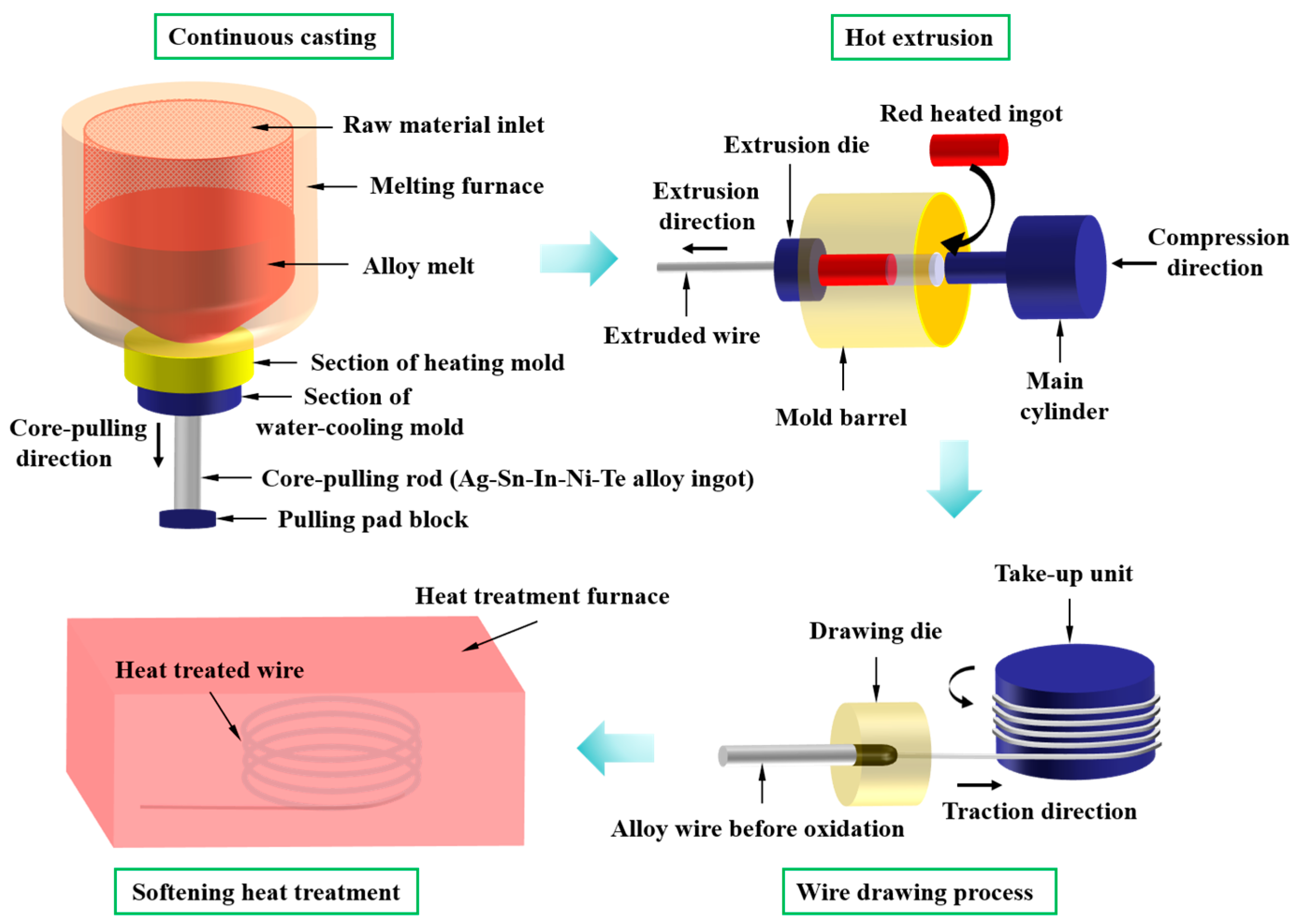

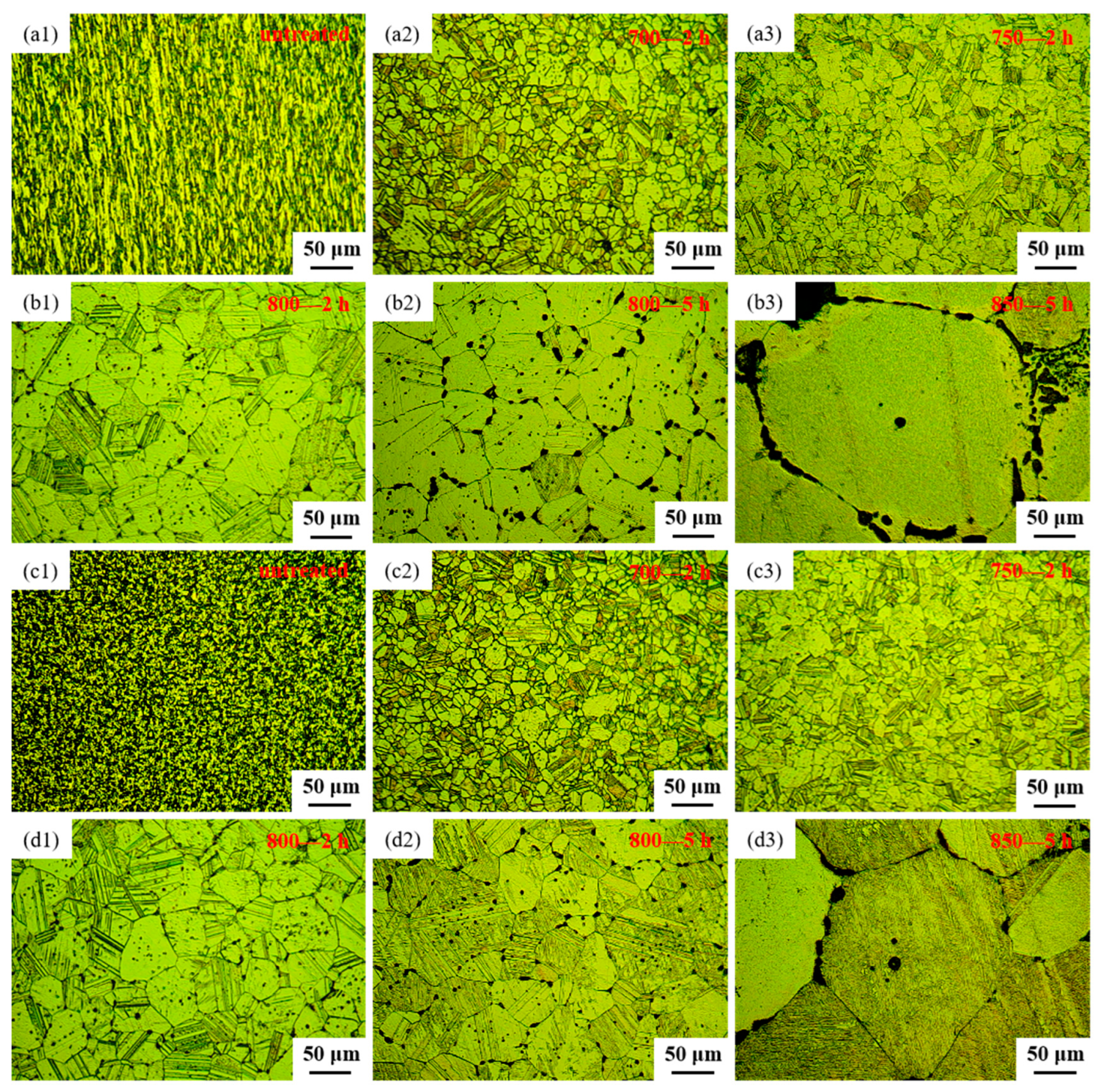
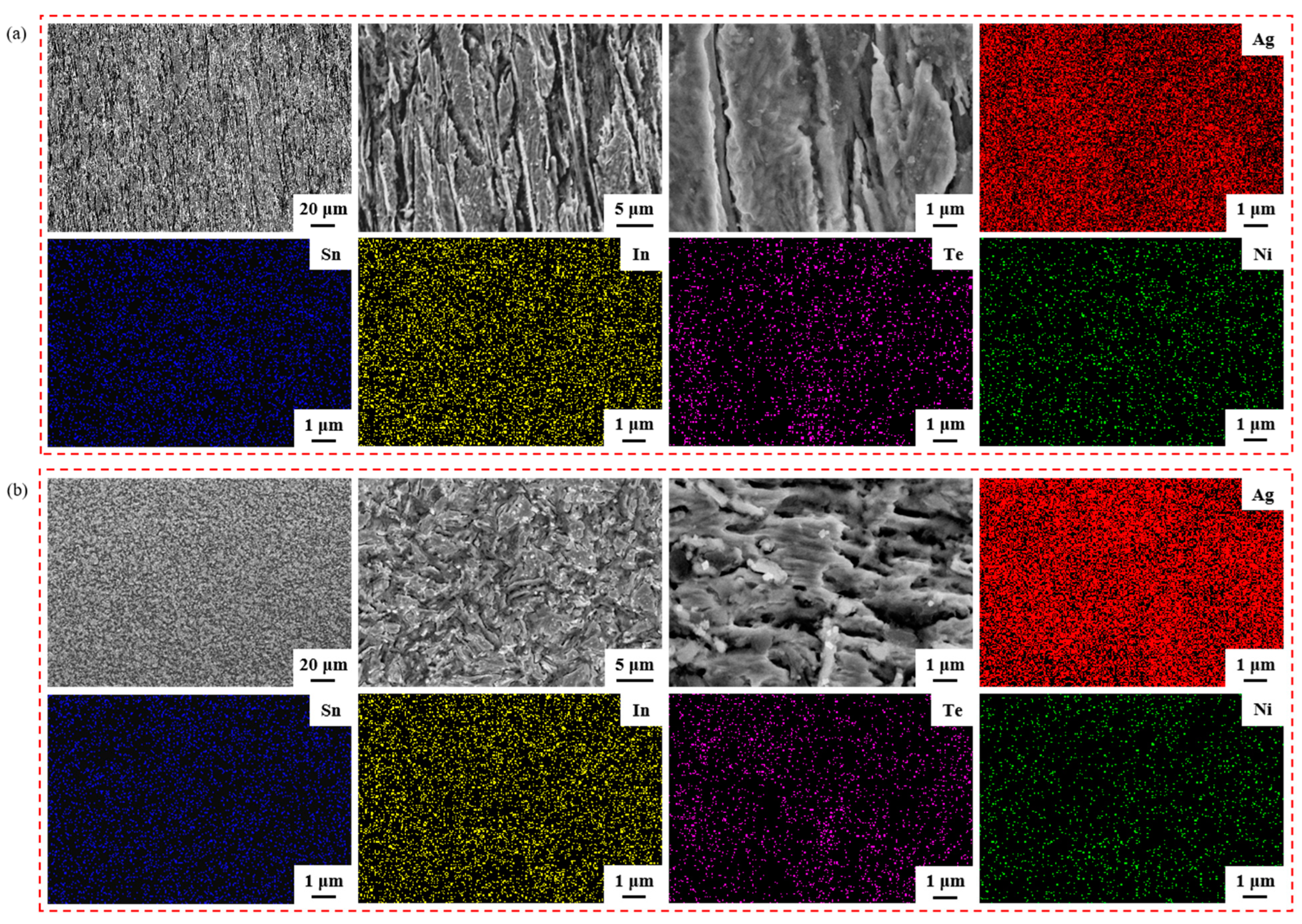


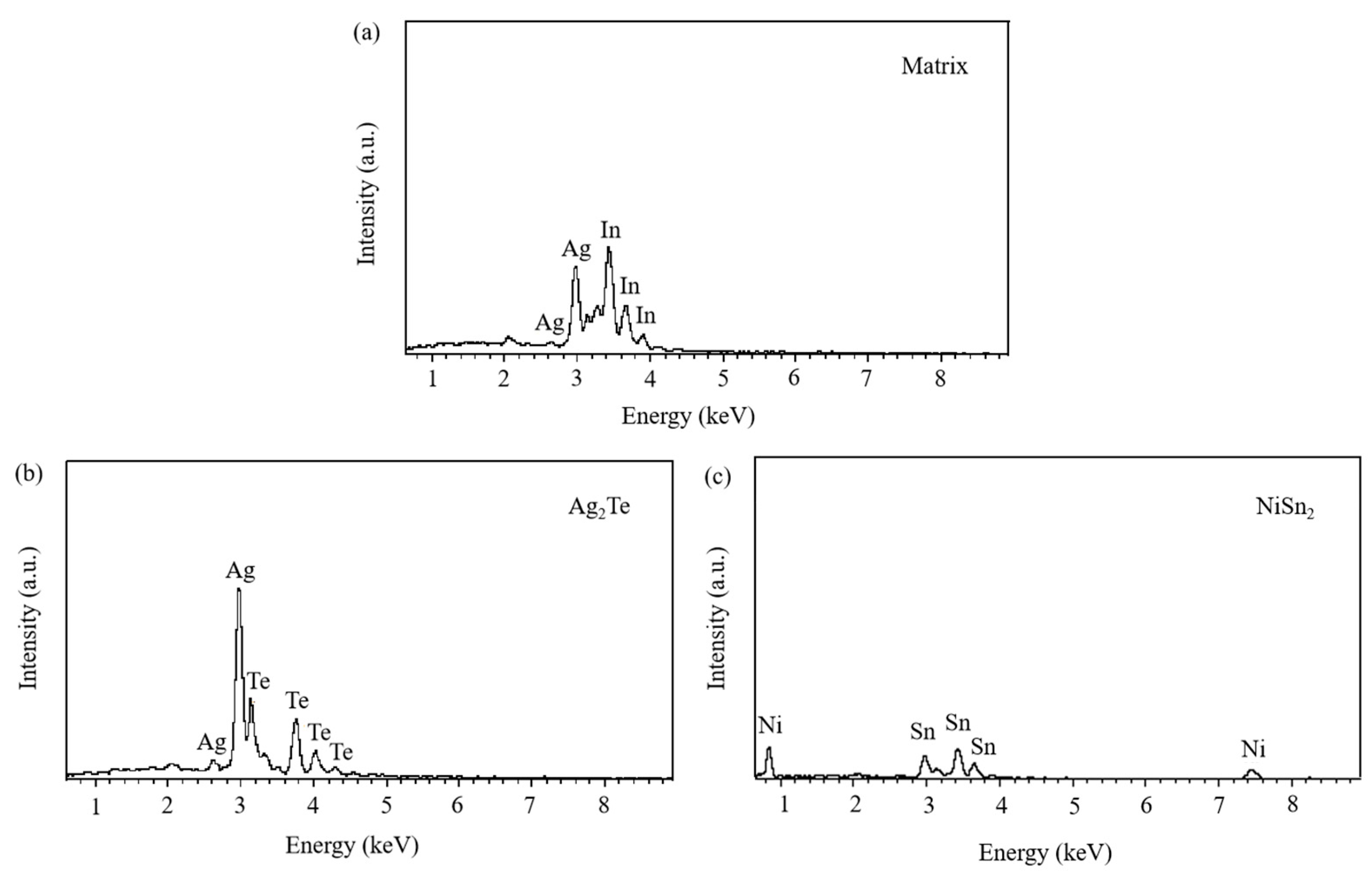

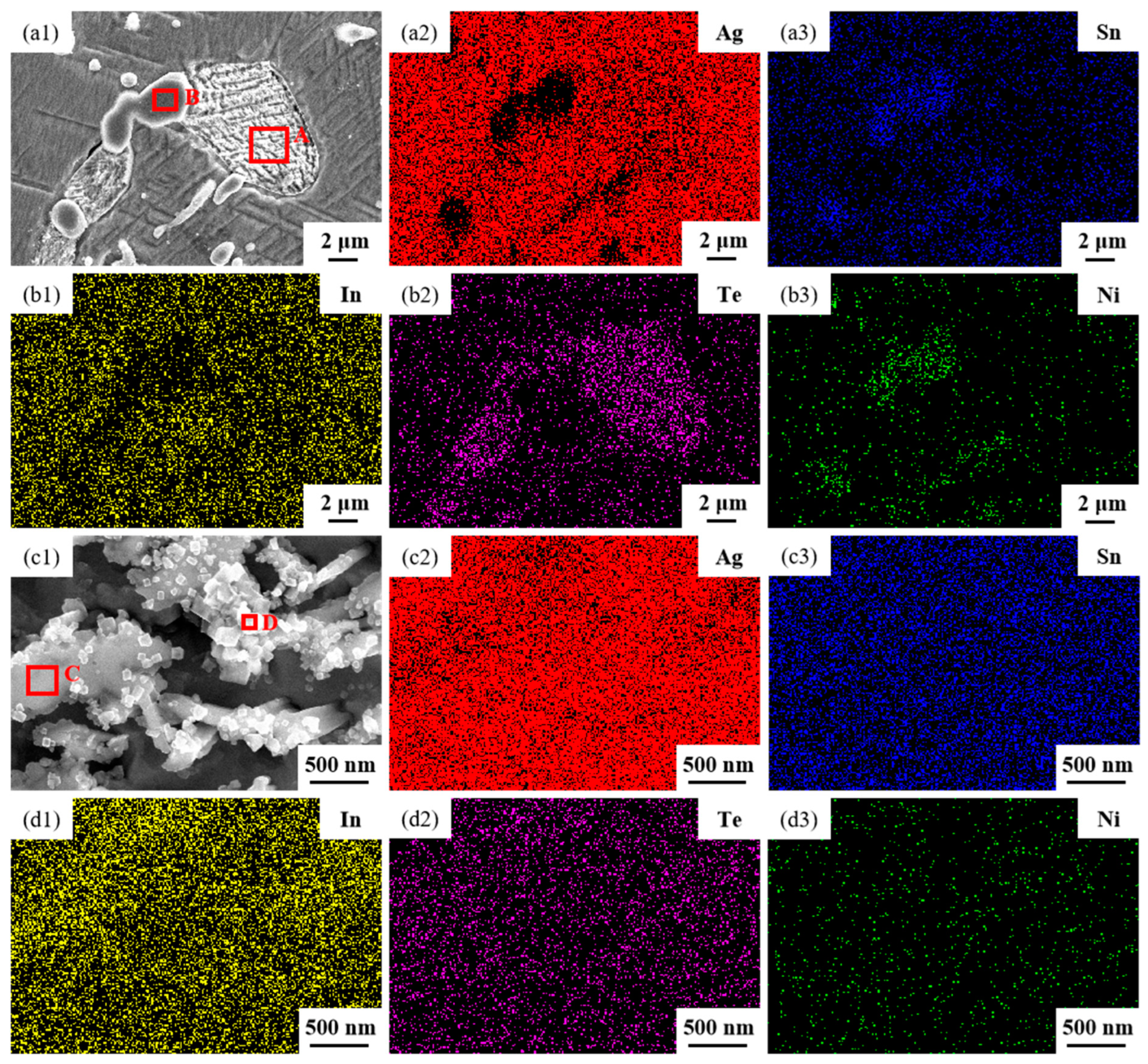
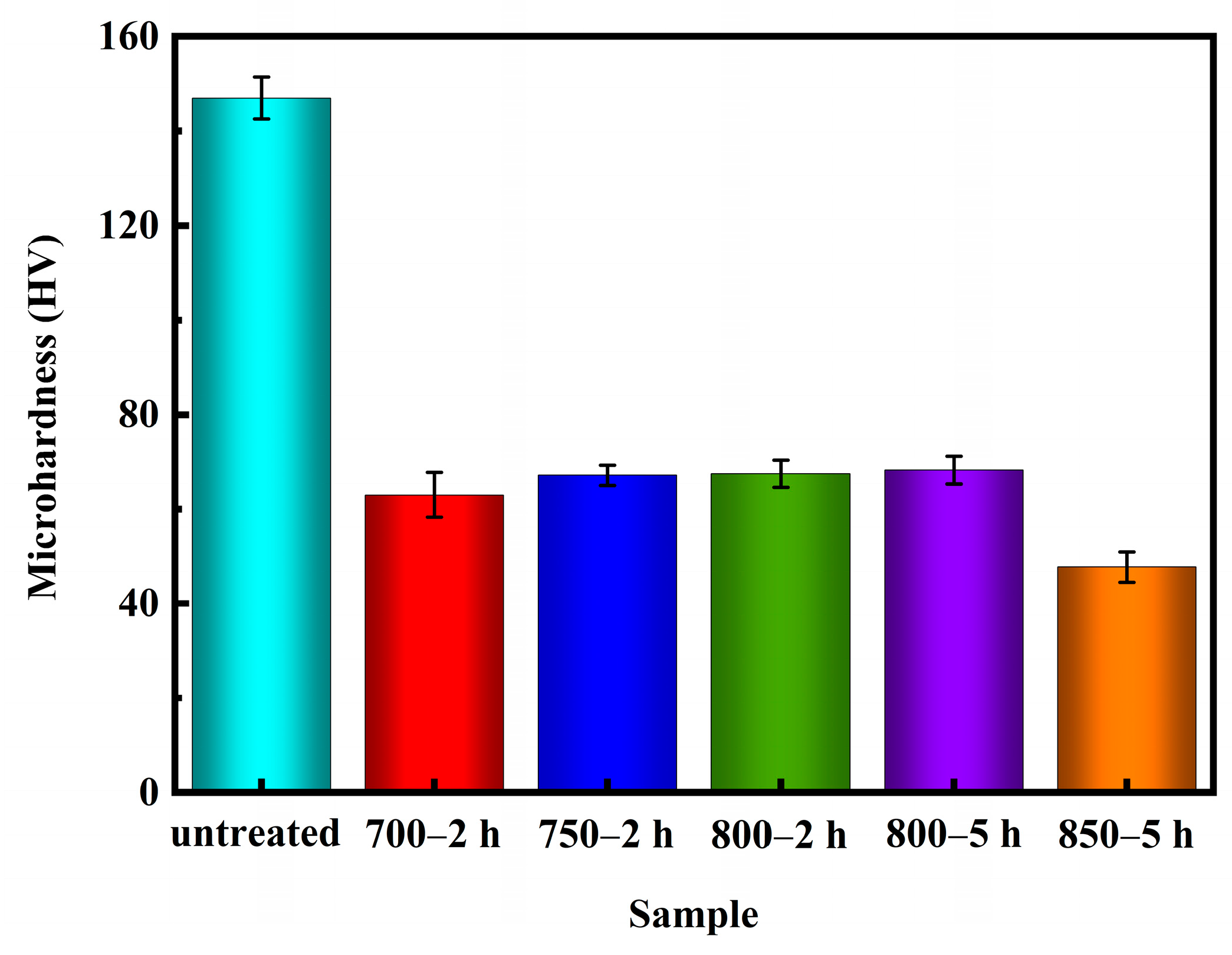

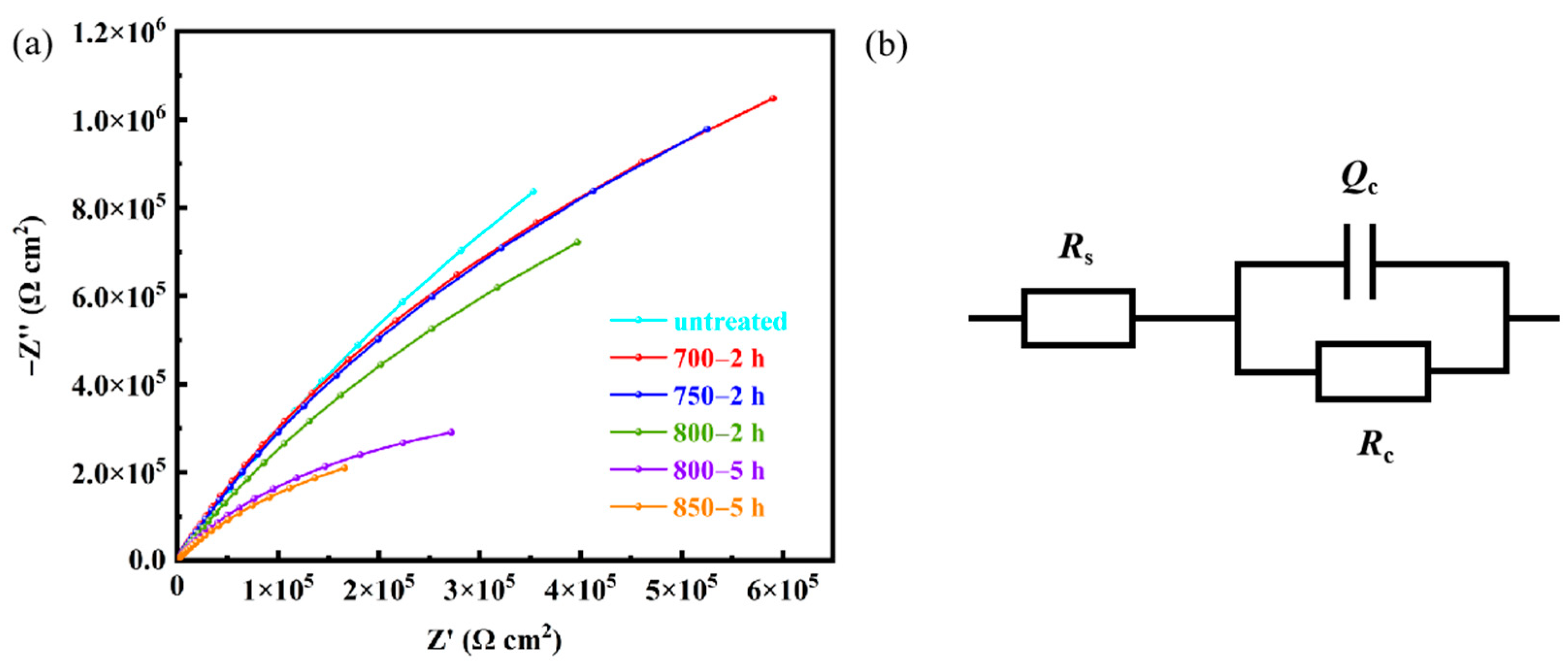
| Element | Ag | Sn | In | Te | Ni |
|---|---|---|---|---|---|
| Theoretical value | 90.55 | 6.0 | 2.5 | 0.8 | 0.15 |
| Measured value | 90.53 | 6.18 | 2.39 | 0.72 | 0.18 |
| Sample | Untreated | 700—2 h | 750—2 h | 800—2 h | 800—5 h | 850—5 h |
|---|---|---|---|---|---|---|
| Temperature (°C) | – | 700 | 750 | 800 | 800 | 850 |
| Time (h) | – | 2 | 2 | 2 | 5 | 5 |
| Sample | A | B | ||
|---|---|---|---|---|
| Ag | Te | Ni | Sn | |
| wt.% | 67.74 | 32.26 | 32.84 | 67.16 |
| at.% | 71.29 | 28.71 | 34.07 | 65.93 |
| Sample | A | B | C | D | ||||
|---|---|---|---|---|---|---|---|---|
| Ag | Te | Ni | Sn | Ag | Sn | Ag | Sn | |
| wt.% | 62.85 | 37.15 | 34.06 | 65.94 | 67.64 | 32.36 | 73.78 | 26.22 |
| at.% | 66.68 | 33.32 | 33.76 | 66.24 | 69.70 | 30.30 | 75.59 | 24.41 |
| Sample | Ecorr (mV) | Icorr (nA cm−2) | ba (mV dec−1) | bc (mV dec−1) | Rp (kΩ cm2) | vcorr (mm year−1) | Rs (Ω cm2) | Rc (Ω cm2) |
|---|---|---|---|---|---|---|---|---|
| untreated | −170.51 ± 24.8 | 42.64 ± 9.9 | 270.42 | 115.31 | 823.21 | 1.14 | 36.41 | 7679.9 |
| 700—2 h | −182.49 ± 15.5 | 60.75 ± 6.4 | 519.61 | 117.61 | 685.48 | 1.62 | 27.66 | 5246.95 |
| 750—2 h | −159.12 ± 24.2 | 66.05 ± 3.2 | 328.89 | 113.5 | 554.72 | 1.76 | 31.01 | 4860.7 |
| 800—2 h | −166 ± 21.0 | 80.42 ± 1.8 | 670.17 | 118.41 | 543.34 | 2.14 | 28.83 | 4248.8 |
| 800—5 h | −189.46 ± 2.0 | 87.55 ± 7.8 | 401.81 | 133.48 | 496.93 | 2.33 | 28.92 | 2865.9 |
| 850—5 h | −156.92 ± 4.5 | 91.71 ± 3.7 | 332.26 | 115.52 | 405.84 | 2.44 | 27.66 | 911.550 |
Disclaimer/Publisher’s Note: The statements, opinions and data contained in all publications are solely those of the individual author(s) and contributor(s) and not of MDPI and/or the editor(s). MDPI and/or the editor(s) disclaim responsibility for any injury to people or property resulting from any ideas, methods, instructions or products referred to in the content. |
© 2024 by the authors. Licensee MDPI, Basel, Switzerland. This article is an open access article distributed under the terms and conditions of the Creative Commons Attribution (CC BY) license (https://creativecommons.org/licenses/by/4.0/).
Share and Cite
Shao, L.; Zhang, S.; Hu, L.; Wu, Y.; Huang, Y.; Le, P.; Dai, S.; Li, W.; Xue, N.; Xu, F.; et al. Influence of Heat Treatment Condition on the Microstructure, Microhardness and Corrosion Resistance of Ag-Sn-In-Ni-Te Alloy Wire. Materials 2024, 17, 2785. https://doi.org/10.3390/ma17112785
Shao L, Zhang S, Hu L, Wu Y, Huang Y, Le P, Dai S, Li W, Xue N, Xu F, et al. Influence of Heat Treatment Condition on the Microstructure, Microhardness and Corrosion Resistance of Ag-Sn-In-Ni-Te Alloy Wire. Materials. 2024; 17(11):2785. https://doi.org/10.3390/ma17112785
Chicago/Turabian StyleShao, Ling, Shunle Zhang, Liepeng Hu, Yincheng Wu, Yingqi Huang, Ping Le, Sheng Dai, Weiwei Li, Na Xue, Feilong Xu, and et al. 2024. "Influence of Heat Treatment Condition on the Microstructure, Microhardness and Corrosion Resistance of Ag-Sn-In-Ni-Te Alloy Wire" Materials 17, no. 11: 2785. https://doi.org/10.3390/ma17112785





